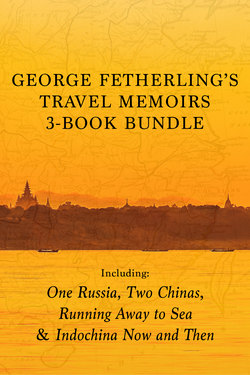Читать книгу George Fetherling's Travel Memoirs 3-Book Bundle - George Fetherling - Страница 36
На сайте Литреса книга снята с продажи.
Photo Insert Part 2
Оглавление
The militarism that made French rule possible was another lively visual topic. But images showcasing regular French troops — such as this informal grouping of marsouins (“porpoises,” a slang term for common soldiers with long colonial service) are unusual: everyone back home already knew what they looked like. What sold were pictures of exotic natives in the service of France — even the drum and bugle corps attached to a unit of tirailleurs (the word can mean either “skirmishers” or “sharpshooters”).
This photo is especially evocative: the young Vietnamese cavalryman has a fine pony, a crisp white uniform, a polished sabre — but no shoes.
Punishment is another theme of postcards from Indochina. The photo of a Vietnamese prisoner pleading before a local tribunal is cautionary, but not particularly frightening, even though the young man on the far left carries a crossbow. In contrast, gruesome images of decapitated prisoners were always popular.
Here a Hmong (Mèo in Vietnamese, Miao in Chinese) working for the French exhibits the head of an executed “pirate”: as in China, a generic term for a bandit or ideological opponent, not necessarily one who commits crimes at sea. In keeping with local practice (“selon la coutume du pays”), such pirates’ heads were often put on display, hanging from city walls in baskets or open boxes, accompanied by a written warning from the authorities. In districts closest to China and Burma, crucifixion was another common punishment.
Colonial Laos was less well developed than Vietnam and Cambodia, and this fact was reflected in its postcard iconography. There are fewer scenes of urban life, but proportionately more showing village people, both Lao and members of the ethnic minorities; French faces are rarely glimpsed.
Some images, such as the one that records a gathering of elephant wallahs, are strikingly specific to a distant past. But photos of a local boat race, and one of small passenger and cargo vessels tied up near Luang Prabang, have a more contemporary feel, for much of Lao life still focuses on the Mekong and its tributaries.
Postcards such as this one of a kerbside dealer in soya cheese or the crowds always to be found at Binh Tay Market in Cholon, the city’s Chinatown, remind us that colonial Saigon, like all important Asian cities, was a constant whirl of small-scale commerce. But it was also one on which the French would put their grand and indelible stamp, to remind the world who was in charge.
In the years bridging the nineteenth and twentieth centuries, French neoclassical buildings, some of them inspired by particular Parisian examples, changed the face of Saigon. The Palais du Gouverneur Général de l’Indochine (top), built in 1902, but shown here in 1925, almost reeked of power. Since 1975, the building has been known as the Reunification Palace. Other French structures have retained their original functions. The custom house (middle) is still the custom house. The main post office (bottom; its famous glass dome obscured by trees in this 1920s postcard) also continues to serve its intended purpose.
No doubt inspired in a small way by Baron Georges-Eugène Haussmann, whose development scheme had redrawn the map of Paris during the Second Empire, a generation earlier, the colonial authorities remade the plat of Saigon by creating majestic avenues. One street that required no such reinvention was the Boulevard Bonnard, named for Jean-Louis Bonnard, a Catholic priest executed by Emperor Tu Duc in 1852 (and later canonized). Instead, the French decorated it with important buildings, private and public. One was the Opera House, which much later, after the country was partitioned in 1954, became the National Assembly of the American-backed Republic of South Vietnam. It is now the city’s municipal theatre. The boulevard has been renamed Le Loi Street, after the Vietnamese general who defeated the Chinese six hundred years ago.
Beginning in 1802, Hué, located on the Perfume River about midway between Saigon and Hanoi, was the seat of the Nguyen emperors. It is now the site of their elaborate tombs.
The French took Hué by force in 1885, looting the palace. But they permitted the monarchy to survive, at least nominally, until 1945.
Accordingly, most colonial-era postcards of the city detail court life, with its retainers, attendants, and its various ceremonies and celebrations. The city, with its famous citadel, was the scene of fierce fighting during the Tet Offensive of 1968.
This missionary on his way to evangelize the Tonkinese is a reminder that the impulses behind the French mission civilatrice were Christian as well military, political, and commercial. Hanoi became the most heavily Roman Catholic city in Indochina, but Buddhism, of course, remained the dominant belief system, there and throughout most of Asia.
Before and after the colonial period, just as during it, Hanoi certainly had its earthy aspects, but also enjoyed a large middle class of cultured Vietnamese. Private citizens, for example, financed the bridge, shown here on a 1920s postcard, that connects central Hanoi to Nogoc Son Temple, on a tiny island in Hoan Kiem Lake.
